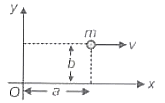A man of mass m starts moving on a plank of mass M with constant velocity v with respect to plank. If the plank lles on a smooth horizontal surface, then velocity of plank with respect to ground is
(1)
(2)
(3)
(4)
A ball of mass m is thrown upward and another ball of same mass is thrown downward so as to move freely under gravity. The acceleration of centre of mass is
(1) g
(2)
(3) 2g
(4) Zero
A hollow sphere of mass 1 kg and radius 10 cm is free to rotate about its diameter. If a force of 30 N is applied tangentially to it, its angular acceleration is (in rad/s2)
(1) 5000
(2) 450
(3) 50
(4) 5
Two equal and opposite forces are applied tangentially to a uniform disc of mass M and radius R as shown in the figure. If the disc is pivoted at its centre and free to rotate in its plane, the angular acceleration of the disc is
(1)
(2)
(3)
(4) Zero
A wheel having moment of inertia 4 kg m2 about its symmetrical axis, rotates at rate of 240 rpm about it. The torque which can stop the rotation of the wheel in one minute is
(1)
(2)
(3)
(4)
A force acts at a point The torque of the force about the point is
(1)
(2)
(3)
(4)
A particle of mass m is moving with constant velocity v parallel to the x-axis as shown in the figure. Its angular momentum about origin O is

(1) mvb
(2) mva
(3)
(4) mv (a + b)
A particle of mass 5 kg is moving with a uniform speed 3 in XOY plane along the line Y = X + 4. The magnitude of its angular momentum about the origin is
(1) 40 units
(2) 60 units
(3) Zero
(4) 40 units
For equilibrium of the system, value of mass m should be

(1) 9 kg
(2) 15 kg
(3) 21 kg
(4) 1 kg
The moment of inertia of a body depends on
(1) The mass of the body
(2) The distribution of the mass in the body
(3) The axis of rotation of the body
(4) All of these







